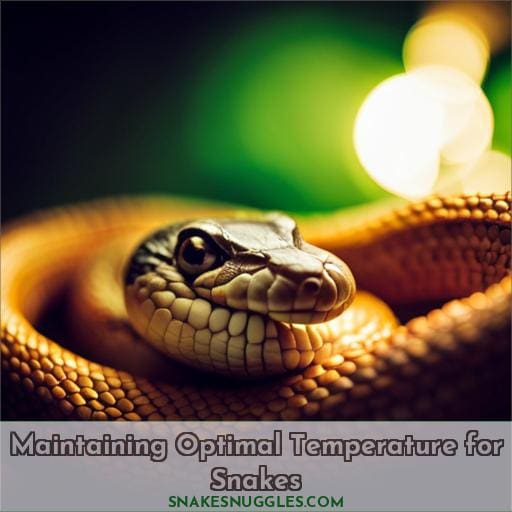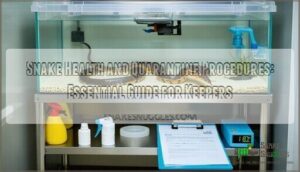This site is supported by our readers. We may earn a commission, at no cost to you, if you purchase through links.
 Time flies when you are having fun! But for a snake, it can be the difference between life and death if they get too cold. When left in the cold without proper temperature regulation, snakes can experience hypothermia as well as digestive issues that could lead to organ failure and even death.
Time flies when you are having fun! But for a snake, it can be the difference between life and death if they get too cold. When left in the cold without proper temperature regulation, snakes can experience hypothermia as well as digestive issues that could lead to organ failure and even death.
Therefore, it is important to ensure your pet snake has adequate heat sources at all times. In this article, we will discuss warning signs of Cold Stress in Snakes, health risks associated with exposure to low temperatures, steps necessary for maintaining an optimal temperature environment, and tips on how to best prevent cold shock syndrome from occurring.
So let’s dive deep into understanding what happens when a Snake Gets Too Cold – Warning Signs & Prevention Tips!
Table Of Contents
- Key Takeaways
- Signs of Cold Stress in Snakes
- Health Risks of Cold Exposure in Snakes
- Importance of Proper Temperature for Snakes
- Snakes’ Natural Response to Cold
- Potential Consequences of Cold Shock in Snakes
- Maintaining Optimal Temperature for Snakes
- Tips for Preventing Cold Stress in Snakes
- Frequently Asked Questions (FAQs)
- Conclusion
Key Takeaways
- Snakes are susceptible to cold stress without adequate heat sources.
- Cold stress can lead to various health issues and even death if not addressed promptly.
- Warning signs of cold stress include lethargy, dry scales, sunken eyes, and loss of appetite.
- Snakes require a thermal gradient of 75-90°F for optimal health and functioning.
Signs of Cold Stress in Snakes
When a snake is too cold, there are several signs to look out for, including lethargy, dry scales, sunken eyes, and loss of appetite. These symptoms can be indicative of cold stress, as snakes require warmth to maintain their health and well-being.
Lethargy
You may notice your snake becoming lethargic and moving slowly when exposed to cold temperatures, which is a sign of hypothermia. Cold shock syndrome can occur after sudden temperature drops and cause organ failure or death.
Prolonged exposure to cold weakens the immune system and leads to regurgitation due to energy conservation.
Snakes often enter a brumation state in colder climates, reducing activity levels while searching for warmth. Heated enclosures are necessary for snakes as they rely on external sources of heat for survival and digestion.
The optimal tank temperature should be between 75-90°F with basking spots reaching 90°F or higher.
Maintaining consistent temperatures helps avoid hypothermia, but backup solutions like hot water bottles must be prepared during power outages or relocation needed in emergencies.
Dry Scales
When temperatures drop, you may notice your snake’s scales becoming dry and brittle. This is a sign of cold stress as the animal struggles to maintain its body temperature with limited heat sources available in colder environments.
Heat loss increases their susceptibility to infection due to weakened immune systems, and can lead them into brumation or even freezing shock if left unchecked.
To avoid these issues, provide species-appropriate warmth, like basking spots or burrows where they can find shelter from the cold environment while maintaining optimal body temperature for digestion and immunity functions.
Prolonged exposure will cause regurgitation of food due to inability to digest it properly in such conditions.
Sunken Eyes
Sunken eyes are an ominous sign that your snake has been exposed to a chill, and it’s time to act fast. Cold shock syndrome can be deadly if not managed quickly, with temperature drops making the snake more vulnerable to infections due to its weakened immune system.
Heat sources, such as sunlight or lamps, should be provided in order for the pet caretaker to maintain optimal tank temperature conditions. Energy conservation techniques, like brumation, help snakes survive colder external environments.
Power outages may require hot water bottles and other temporary solutions to keep temperatures high enough so vital organs do not shut down from cold exposure or cause respiratory infections due to low warmth levels.
Ensuring adequate heat is essential in maintaining healthy reptiles. Swift action is needed when sunken eyes appear!
Loss of Appetite
When temperatures plummet, your snake may refuse food to conserve energy and stay warm. This is a common sign of cold stress in snakes that can be caused by environmental factors or species-specific needs.
To prevent hypothermia, create a thermal gradient with thermostats and use heated water bottles for extra warmth when necessary.
Monitor ambient temperature carefully to ensure it’s suitable for the species you own; most snakes are adversely affected below 70°F. In snowy areas, burrowing beneath the frost level helps keep them safe from cold shock while aquatic varieties rely on adaptations like thicker skin and increased fat reserves to survive icy waters.
Taking preventative measures such as providing adequate heat sources will ensure your pet stays healthy year-round!
Health Risks of Cold Exposure in Snakes
Cold exposure in snakes can have dire consequences on their health, including respiratory infections, regurgitation of food, digestive issues, and weakened immunity. When temperatures drop too low for extended periods of time, it leads to hypothermia and other cold-induced ailments that can be fatal if not addressed quickly.
Respiratory Infections
Prolonged exposure to cold temperatures can weaken a snake’s immune system and lead to respiratory infections, with symptoms such as wheezing and nasal discharge. Recognizing these signs is essential. Temperature regulation and hypothermia prevention through appropriate heat source selection are important, as well as adaptive behaviors like seeking warmth in the basking area.
To ensure health, one should use digital thermometers or temperature guns for regular monitoring of enclosure temperatures. Without adequate warmth, snakes become lethargic due to decreased body temperature, and digestion shuts down, ultimately leading to death.
Regurgitation of Food
Cold temperatures can cause your reptilian friend to regurgitate their meals, leading to wasted energy and further health complications. Snakes must maintain a certain temperature for digestion and immunity; otherwise, they become lethargic, stop eating, or even vomit up food.
To avoid hypothermia and regulate body temperature, species-adapted snakes either burrow in warm hides or seek sun basks, while water snakes rely on heated rocks. Species such as sea snakes are specially adapted for cold waters, but all other reptiles face death due to freezing temperatures if not properly cared for at home with the right heat source.
Keeping an eye on enclosure temps is essential since sudden drops can be fatal!
Digestive Issues
Without the right warmth, you risk digestive issues like regurgitation and loss of appetite. Cold shock can lead to organ failure if not treated with medical intervention. Heat sources like the sun or radiant heat panels help snakes regulate temperature in colder environments.
But sudden temperature drops can cause energy conservation measures, such as refusal to eat or hibernation-like brumation states. Survival instincts kick in when faced with cold temperatures – burrowing under frost level, seeking shelter from the wind – but without proper settings, this isn’t enough for a snake’s health.
Weakened Immune System
Exposure to cooler temperatures may weaken a snake’s immunity, leaving it vulnerable to respiratory infections and other health issues. Cold shock can cause organ failure leading to death if the temperature drops too quickly.
Heat sources like lamps and basking spots are essential for maintaining optimal temperature levels in pet enclosures.
Temperature gradient is also important – warm on one side, cool on the other – for snakes’ metabolic needs and overall well-being. Without adequate warmth, snakes suffer from digestive problems due to slowed metabolism or refusal of food, which weakens their immune system further over time.
Pet owners should take necessary precautions such as providing external heat sources during power outages or keeping thermostats in check, ensuring that cages never drop below 70°F so their pets stay safe from cold stress-related ailments.
Importance of Proper Temperature for Snakes
Maintaining proper temperature is vital for snake health and well-being. Temperatures that are too cold can have drastic effects on snakes, disrupting digestion, reducing immunity to infection, compromising organ function, and leading to regurgitation.
Taking the necessary steps to provide a warm environment for your pet snake ensures their continued good health.
Digestion and Immune Function
Without proper warmth, your scaly friend’s digestion and immune system will suffer. Cold temperatures disrupt their ability to digest food as energy must be conserved, leading to regurgitation of meals.
This can cause cold shock syndrome with potentially fatal consequences; symptoms include lethargy and loss of movement. Heat sources like the sun or lamps are vital for snake health – unsuitable temperature increases the risk of respiratory infections and organ failure.
Solutions for power outages: hot water bottles, thermal gradient, and radiant heating panels help provide consistent heat without harming snakes.
Organ Health and Function
Prolonged exposure to cold temperatures can cause serious health issues in snakes, affecting the functionality of their organs. Cold shock syndrome due to sudden temperature drops is fatal, as snakes don’t come back to life once frozen.
To ensure a species-appropriate thermal gradient for your snake’s health and safety during power outages, provide heat sources like the sun or lamps. Maintain the enclosure temperature between 75-90°F with radiant heating panels or hot water bottles.
Hypothermia symptoms in snakes include lethargy, dry scales, and sunken eyes. These symptoms weaken the snake’s immunity, so seek veterinary care immediately if you observe them in your pet snake.
Overall Well-being
Maintaining an adequate temperature is crucial for your snake’s overall well-being, as prolonged exposure to cold temperatures can weaken its immunity and lead to life-threatening health issues. To prevent such problems, you must provide a warm environment with appropriate basking spots and artificial heat sources.
Species differences in thermal tolerance mean that specific warming solutions are necessary. For example, hot water bottles, radiant heating panels, or thermostats with thermometers are needed for consistent heat regulation across the enclosure’s thermal gradient.
Careful monitoring of the temperature is essential for preventing hypothermia or hyperthermia in snakes.
Snakes’ Natural Response to Cold
When snakes get too cold, they instinctively seek warmth in the wild. This can include burrowing underground or basking on rocks to absorb heat from the sun. In some cases, snakes may even enter a pseudo-brumation state as a means of conserving energy and lowering their body temperature during colder temperatures.
Seeking Warmth in the Wild
You must help your pet snake seek warmth in the wild, or it may suffer hypothermia and other deadly conditions. Different species have varying tolerances to cold temperatures. For example, tropical snakes cannot survive in snow while cold-adapted species use burrows beneath the frost level.
Heat sources like the sun or lamps are vital for their health and well-being. Cold temperatures lead to organ failure and even death due to sudden temperature drops known as cold shock syndrome. To maintain optimal temperatures of 75°F on the cooler side and 90°F on the basking area, artificial heating devices such as radiant heat panels can be used along with thermometers and thermostats.
With access to environmental warmth through a range of heat sources, from natural sunlight outdoors to having warm water bottles ready during power outages, you can ensure that your pet will stay healthy despite colder climates.
Pseudo-brumation State
Even in controlled conditions, snakes can enter a pseudo-brumation state with slowed activity at colder temperatures and energy conservation for up to six hours at 75°F. They use cold adaptation techniques like seeking heat sources or burrowing to regulate their temperature.
Cold shock is avoided by providing adequate warmth through basking spots, artificial heating elements, or hot water bottles as backup power outages occur.
Burrowing or Basking Behavior
To survive cold temperatures, snakes will seek out warm spots to bask or burrow in. Basking spots provide direct heat sources and a thermal gradient that keeps a snake’s body temperature regulated.
Heat sources like the sun, lamps, and radiant heating panels can help maintain an ideal enclosure temperature of 75-90°F for optimal health. Regular checks on the enclosure should be made with thermometers to ensure it is not too hot or too cold for your pet snake.
Cold shock syndrome, caused by sudden drops in temperature, must be addressed immediately with warming strategies such as providing heated water bottles or relocating your pet temporarily until power is restored if there are any outages.
Heat is essential for your reptile’s digestion and immune system; without it, they become vulnerable to infections and organ failure, ultimately leading to death.
Potential Consequences of Cold Shock in Snakes
Navigating cold environments can be fatal for snakes. Cold shock syndrome, organ failure, and death are all potential risks of exposing a snake to temperatures that are too low.
Cold Shock Syndrome
When exposed to cold temperatures, snakes can suffer from a potentially fatal condition known as Cold Shock Syndrome. Symptoms include lethargy, dry scales, sunken eyes, and loss of appetite. To prevent this syndrome, snake owners must ensure proper temperature maintenance in their enclosures with heat sources like lamps or thermal gradient hot spots.
Species adaptation also plays a role; some species are more tolerant than others to cold conditions. It’s important for keepers to research the specific requirements of their pet’s species before providing adequate heating solutions such as radiant heating panels or thermostats for precise temperature regulation and monitoring.
Proper management is essential in order to avoid any health risks associated with exposure to cold shock.
Organ Failure
Prolonged exposure to cold temperatures can lead to serious organ failure and even death in snakes. Without adequate heat sources, these ectothermic creatures are unable to regulate their body temperature, leading to hypothermia.
This condition weakens the snake’s organs significantly and affects overall health.
Temperature control should be a priority for any reptile owner. Providing thermal gradient basking spots or radiant heating panels is essential.
Properly monitoring temperature with thermostats and thermometers helps maintain optimal tank conditions for maximum organ health of your pet snake during both hot summers and colder months alike!
Death
Without proper warmth, prolonged cold exposure can lead to lethargy, organ failure, and ultimately death. Cold shock syndrome is a potentially fatal condition that occurs when snakes are exposed to temperatures below 70°F for an extended period of time.
Different species vary in their tolerance. Tropical snakes may not survive even mild snowfall, while others burrow into the frost line as protection. Even with heat sources like the sun or lamps, inadequate temperature will cause hypothermia, which leads to respiratory infections and regurgitation of food due to energy conservation efforts by the snake’s body.
Without intervention from pet owners or veterinary care, extreme cold spells can prove deadly for these creatures. Organs shut down, leading quickly towards demise if conditions don’t improve soon enough.
Maintaining Optimal Temperature for Snakes
Maintaining optimal temperature for snakes is essential for their health and well-being. To avoid cold shock, it is necessary to provide a basking spot or artificial heat source, regularly monitor the enclosure temperature, and be prepared in case of power outages.
Providing adequate warmth ensures snake immunity, digestion, and energy levels remain at an optimum level while avoiding any potential health threats due to cold temperatures.
Basking Spots or Heat Sources
To ensure your snake stays healthy, create a warm and inviting environment with adequate basking spots or heat sources. Provide them with a thermal gradient between 75-90°F. This can be achieved by using thermostats and thermometers to monitor temperature.
Heat panels are an ideal solution as they provide controlled heating without harming the snake, even when temperatures drop suddenly.
In case of power outages, use hot water bottles or radiant heating panels for temporary warmth until the issue is resolved. Cold shocks can lead to hypothermia, lethargy, and death if not treated in time.
Temperature Monitoring and Control
Monitoring and controlling the temperature of your snake’s enclosure is essential for their health and well-being. Heat sources, such as the sun or lamps, should be available to regulate the environment.
A thermal gradient within the habitat allows snakes to move between cooler or warmer areas.
Radiant heat panels can provide a safe and controlled heating solution without harming them, while thermostats help maintain consistent temperatures.
To minimize the risk during power outages, warm water bottles can act as temporary heat sources that will keep your pet healthy until electricity returns. However, in extreme cases like cold shock syndrome, relocation may also be necessary.
If you detect symptoms like lethargy or regurgitation, immediate vet care should follow.
Handling Power Outages
In case of power outages, you should be prepared to keep your snake warm with hot water bottles or temporary relocation. For instance, snakes die quickly in very cold water due to heat loss within 6 hours at 75°F.
To prevent this, maintain temperature control by using heat sources like the sun or lamps and provide a basking spot for warmth absorption.
Cold shock can occur suddenly if temperatures drop too low. Tropical snakes cannot survive in snow, while cold-adapted species burrow below the frost level for protection from extreme conditions. It is helpful to have a thermostat and thermometer to monitor the tank’s temperature.
Tips for Preventing Cold Stress in Snakes
Introducing a few key methods for preventing cold stress in snakes, such as warm water bottles, creating a thermal gradient, and using radiant heating panels along with regular temperature checks, will help ensure the reptile’s health and safety.
By following these precautions, you can provide your pet snake with the ideal environment that is suitable for its species, thus helping it thrive without succumbing to dangerous temperatures.
Using Warm Water Bottles
Power outages can be managed with warm water bottles to help keep snakes’ temperatures regulated. Alternative heat sources and temperature control should also be considered, such as using a heat lamp or heating pad.
Temperature drops are especially dangerous for cold-blooded creatures like snakes – they need warmth from their environment in order to survive. Water snakes and sea snakes have specific adaptations for surviving in cold waters, but most other species require an artificial source of warmth when kept indoors or during power outages.
Heat lamps and warm water bottles provide the necessary temperature regulation while maintaining the correct humidity levels needed by many snake species.
Creating a Thermal Gradient
Creating a thermal gradient in your snake’s enclosure can help them stay warm and healthy, allowing them to bask in the warmth of their environment like a ray of sunshine. Heat sources, such as lamps or radiant heat panels, will provide consistent temperature control while preventing heating failures.
You can also create an optimal thermal gradient by arranging hides, basking spots, and cool zones that match the species’ natural needs for warmth or cooling down. Temperature should be monitored closely with thermostats and thermometers to ensure proper conditions are maintained at all times.
The minimum temperature on one side should be 75°F, with a general temperature of 80°F and a basking spot temperature of 90°F.
With this setup, you’ll have peace of mind knowing your pet is comfortable no matter what nature throws its way. This guarantees healthier digestion, energy conservation, and overall well-being.
Radiant Heating Panels
Radiant heating panels provide controlled warmth for snakes without the risk of harming them. They are a great way to regulate temperature and avoid cold shocks or pseudo brumation.
- Radiant heaters evenly distribute heat throughout an enclosure, preventing hotspots that can cause burns.
- Heating control is maintained by thermostats and thermometers in order to keep temperatures within a safe range for snake health.
- Temperature regulation helps promote digestion, immune function, movement, energy conservation, and overall well-being in snakes.
Cold shocks due to power outages can be avoided by having backup solutions like hot water bottles or temporary relocation of the pet reptile when necessary.
Regular Temperature Checks
Regularly checking the temperature of your snake’s enclosure is crucial for maintaining its health and well-being. If it drops too low, your snake can suffer from cold shock or hypothermia, leading to organ failure.
A good way to avoid this is by providing adequate heat sources like lamps or radiant heating panels. These create a thermal gradient in the tank, allowing snakes to regulate their body temperatures and enter a brumation state if needed.
It is important to monitor these heat sources closely, as prolonged exposure can cause serious harm.
Frequently Asked Questions (FAQs)
What is the ideal tank temperature for snakes?
For optimal snake health, the ideal tank temperature is between 75-90°F. Temperatures above 95°F can be harmful, while below 65°F can lead to hypothermia and even death. Heat sources such as radiant panels or hot water bottles create a thermal gradient for your pet’s well-being, ensuring they have access to warmth when needed! Metaphorically speaking, snakes need heat like plants need sunlight – both are essential for survival and flourishing.
How do snakes prepare for cold months in the wild?
In the wild, snakes prepare for colder months by seeking out warmth in burrows or basking spots. They’ll also enter a pseudo-brumation state to conserve energy and protect themselves from cold shock syndrome that can lead to death.
Staying warm is crucial for their digestion, immune function, and overall well-being.
How can I tell if my snake has a respiratory infection?
If your snake is displaying symptoms of wheezing and nasal discharge, it may indicate a respiratory infection. Monitor the temperature to ensure the enclosure is not too cold, as this can weaken the immune system and make them more susceptible to infections.
How should I manage a power outage in a snake’s enclosure?
In the event of a power outage, provide warmth to your snake’s enclosure with hot water bottles or radiant heating panels. Create a thermal gradient and monitor temperatures with thermometers and thermostats for consistent heat.
This will help maintain proper health in your pet while preventing cold shock syndrome, hypothermia, lethargy, respiratory infections, and organ failure, all of which can be fatal.
What are the different adaptations of water and sea snakes?
Water and sea snakes are adaptive swimmers, navigating the depths with agility. They have adapted layers of insulation to keep them warm in chilly habitats through specialized scales, fins, and flaps that trap heat.
These species also possess a unique ability to absorb oxygen from the water while submerged for extended periods of time.
Conclusion
It’s essential to maintain optimal temperatures for snakes to ensure their health and well-being. Many snake species suffer from cold shock or death when temperatures drop below 70°F. To prevent these adverse consequences, it’s important to provide a thermal gradient, basking spots, and heat sources like lamps and radiant heating panels.
Interestingly, snakes have adapted to cold environments, with some species surviving in snow. However, they require warmth for digestion, movement, and energy. If the temperatures are too low, snakes become lethargic, experience regurgitation, and have weakened immunity.
Therefore, providing appropriate warmth for snakes is essential for their safety and longevity.










